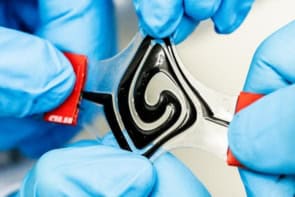
It’s been a good couple of months for perovskite solar cells, with a trio of new results that could make it easier to commercialize these next-generation devices.
The first result concerns perovskite-only solar photovoltaic (PV) cells. The initial promise of perovskite solar cells has long been impaired by the unstable nature of these crystalline materials, which are prone to surface defects that impede the flow of charge carriers (electrons and holes). Annoyingly, heat and moisture – both unavoidable in any practical solar-energy device – make this instability worse. Consequently, perovskite solar cells can lose around a third of their efficiency after just a few hundred hours’ exposure to sunlight.
Last year, Stefaan de Wolf and colleagues at King Abdullah University of Science and Technology (KAUST) in Saudi Arabia took an important step towards solving this problem by constructing a cell that incorporates both three-dimensional and two-dimensional perovskite crystals. This multidimensional cell retained 95% of its initial efficiency after 1000 hours of exposure to sunlight at a temperature of 85°C and a relative humidity of 85%.
In the latest study, published in Joule, Kai Liu and colleagues at Fudan University in China and the University of Victoria in Canada went a little further. Their cell retained 98.6% of its initial efficiency after 1000 hours of operational tests, thanks to a chemical coating that forms covalent bonds with the organic components in perovskites. According to the University of Victoria spin-out firm behind the coating, XLYNX, these bonds make the perovskite more stable, thereby limiting losses of efficiency, stability and performance.
Efficiency records tumble for tandem cells
The second promising result is a new efficiency record for so-called “tandem” solar cells, which combine perovskites with standard silicon material. In mid-April, researchers at KAUST, also led by de Wolf, announced that they had produced an experimental tandem cell with a power conversion efficiency of 33.2%. This value surpasses the previous world record of 32.5%, which was set in late 2022 by Steven Albrecht and colleagues at Helmholtz-Zentrum Berlin.
Though the latest KAUST result has not been published yet, the team say the record has been certified by the European Solar Test Installation (ESTI). The KAUST cell is also currently at the top of the US National Renewable Energy Laboratory’s (NREL) Best Research-cell Efficiency Chart, though it may not stay there for long, given the recent pattern of competing research groups leapfrogging each other’s achievements.

Want to slash your energy bill? Try these record-breaking solar cells
The final new result is yet another efficiency record, this time in a commercial product rather than an experimental device. On 24 May, the UK-based firm Oxford PV reported that a tandem cell manufactured at its production line near Berlin, Germany, converted 28.6% of incident solar energy into electricity. This figure, which has been certified by experts at Fraunhofer ISE in Freiburg, Germany, is significantly higher than the 22-24% typical of commercial silicon cells, and 1.5% above Oxford PV’s own record for a production-line device. Onwards and upwards!



